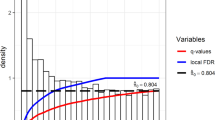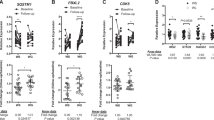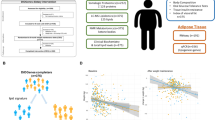Abstract
Objective:
Obese patients respond differently to weight loss interventions. No efficient diagnostic tool exists to separate obese patients into subtypes as a means to improve prediction of response to interventions. We aimed to separate obese subjects into distinct subgroups using microarray technology to identify gene expression-based subgroups to predict weight loss.
Design:
A total of 72 obese men and women without family history of diabetes were enrolled in the study; 52 were treated with ephedra and caffeine (E+C) and 20 with placebo for 8 weeks. Adipose and skeletal muscle tissue biopsies were performed at baseline. RNA sample pairs were labeled and hybridized to oligonucleotide microarrays. Quantile normalization and gene shaving were performed, and a clustering algorithm was then applied to cluster subjects based on their gene expression profile. Clusters were visualized using heat maps and related to weight changes.
Results:
Cluster analysis of gene expression data revealed two distinct subgroups of obesity and predicted weight loss in response to the treatment with E+C. One cluster (‘red’) decreased to 96.87±2.35% body weight, and the second cluster (‘green’) decreased to 95.59±2.75% body weight (P<0.05). ‘Red’ cluster had less visceral adipose tissue mass (2.77±1.08 vs 3.43±1.49 kg; P<0.05) and decreased size of the very large fat cells (1.45±0.61 vs 2.16±1.74 μl; P<0.05) compared to ‘green’ cluster. Gene expression for both skeletal muscle and adipose tissue was also different between clusters.
Conclusions:
Our study provides the first evidence that the combined approach of gene expression profiling and cluster analysis can identify discrete subtypes of obesity, these subtypes have different physiological characteristics and respond differently to an adrenergic weight loss therapy. This brings us that into an era of personalized treatment in the obesity clinic.
This is a preview of subscription content, access via your institution
Access options
Subscribe to this journal
Receive 12 print issues and online access
$259.00 per year
only $21.58 per issue
Buy this article
- Purchase on Springer Link
- Instant access to full article PDF
Prices may be subject to local taxes which are calculated during checkout




Similar content being viewed by others
References
White MA, Whisenhunt BL, Williamson DA, Greenway FL, Netemeyer RG . Development and validation of the food-craving inventory. Obes Res 2002; 10: 107–114.
Stunkard A . Two eating disorders: binge eating disorder and the night eating syndrome. Appetite 2000; 34: 333–334.
Levine JA, Eberhardt NL, Jensen MD . Role of nonexercise activity thermogenesis in resistance to fat gain in humans (see comments). Science 1999; 283: 212–214.
Ukropcova B, McNeil M, Sereda O, de Jonge L, Xie H, Bray GA et al. Dynamic changes in fat oxidation in human primary myocytes mirror metabolic characteristics of the donor. J Clin Invest 2005; 115: 1934–1941.
Guy-Grand B, Apfelbaum M, Crepaldi G, Gries A, Lefebvre P, Turner P . International trial of long-term dexfenfluramine in obesity. Lancet 1989; 2: 1142–1145.
Lefevre M, Greenway FL, Smith SR, Ryan DH, Bray GA, Morales S et al. Genetic Mutations That Predict Weight Loss In An Obesity Treatment Program. Int J Obes 1998; 22 (Suppl. 3): P61.
Torgerson JS, Carlsson B, Stenlof K, Carlsson LM, Bringman E, Sjostrom L . A low serum leptin level at baseline and a large early decline in leptin predict a large 1-year weight reduction in energy-restricted obese humans. J Clin Endocrinol Metab 1999; 84: 4197–4203.
Verdich C, Toubro S, Buemann B, Holst JJ, Bulow J, Simonsen L et al. Leptin levels are associated with fat oxidation and dietary-induced weight loss in obesity. Obes Res 2001; 9: 452–461.
Smith SR, Zachwieja JJ . Visceral adipose tissue: a critical review of intervention strategies. Int J Obes Relat Metab Disord 1999; 23: 329–335.
West M, Blanchette C, Dressman H, Huang E, Ishida S, Spang R et al. Predicting the clinical status of human breast cancer by using gene expression profiles. Proc Natl Acad Sci USA 2001; 98: 11462–11467.
Sorlie T, Perou CM, Tibshirani R, Aas T, Geisler S, Johnsen H et al. Gene expression patterns of breast carcinomas distinguish tumor subclasses with clinical implications. Proc Natl Acad Sci USA 2001; 98: 10869–10874.
Perou CM, Sorlie T, Eisen MB, van de Rijn M, Jeffrey SS, Rees CA et al. Molecular portraits of human breast tumours. Nature 2000; 406: 747–752.
Alizadeh AA, Ross DT, Perou CM, van de Rijn M . Towards a novel classification of human malignancies based on gene expression patterns. J Pathol 2001; 195: 41–52.
Forner F, Foster LJ, Campanaro S, Valle G, Mann M . Quantitative proteomic comparison of rat mitochondria from muscle, heart, and liver. Mol Cell Proteomics 2006; 5: 608–619.
Kamei Y, Miura S, Suzuki M, Kai Y, Mizukami J, Taniguchi T et al. Skeletal muscle FOXO1 (FKHR) transgenic mice have less skeletal muscle mass, down-regulated Type I (slow twitch/red muscle) fiber genes, and impaired glycemic control. J Biol Chem 2004; 279: 41114–41123.
Merkel M, Eckel RH, Goldberg IJ . Lipoprotein lipase: genetics, lipid uptake, and regulation. J Lipid Res 2002; 43: 1997–2006.
Smith SR, Lovejoy JC, Greenway F, Ryan D, Dejonge L, De La Bretonne J et al. Contributions of total body fat, abdominal subcutaneous adipose tissue compartments, and visceral adipose tissue to the metabolic complications of obesity. Metabolism 2001; 50: 425–435.
de Jonge L, Agoues I, Garrel DR . Decreased thermogenic response to food with intragastric vs. oral feeding. Am J Physiol 1991; 260: E238–E242.
Elia M, Livesey G . Theory and validity of indirect calorimetry during net lipid synthesis. Am J Clin Nutr 1988; 47: 591–607.
Smith SR, Gawronska-Kozak B, Janderova L, Nguyen T, Murrell A, Stephens JM et al. Agouti expression in human adipose tissue: functional consequences and increased expression in type 2 diabetes. Diabetes 2003; 52: 2914–2922.
Sparks LM, Xie H, Koza RA, Mynatt R, Hulver MW, Bray GA et al. A high-fat diet coordinately downregulates genes required for mitochondrial oxidative phosphorylation in skeletal muscle. Diabetes 2005; 54: 1926–1933.
Harris RB, Ramsay TG, Smith SR, Bruch RC . Early and late stimulation of ob mRNA expression in meal-fed and overfed rats. J Clin Invest 1996; 97: 2020–2026.
Smith SR, Xie H, Baghian S, Needham A, McNeil M, Bogacka I et al. Pioglitazone chnages the distribution of adipocyte size in type 2 diabetics. Adipocytes 2006; 2: 11–22.
Bolstad BM, Irizarry RA, Astrand M, Speed TP . A comparison of normalization methods for high density oligonucleotide array data based on variance and bias. Bioinformatics 2003; 19: 185–193.
Hastie T, Tibshirani R, Eisen MB, Alizadeh A, Levy R, Staudt L et al. ‘Gene shaving’ as a method for identifying distinct sets of genes with similar expression patterns. Genome Biol 2000; 1 (2): RESEARCH0003.
Thomas PD, Campbell MJ, Kejariwal A, Mi H, Karlak B, Daverman R et al. PANTHER: a library of protein families and subfamilies indexed by function. Genome Res 2003; 13: 2129–2141.
Bjorntorp P . Adipose tissue distribution and function. Int J Obes 1991; 15 (Suppl 2): 67–81.
Vague J . Sexual differentiation. A determinant factor of the forms of obesity. 1947 (classical article) (see comments). Obes Res 1996; 4: 201–203.
Rebuffe-Scrive M, Lonnroth P, Marin P, Wesslau C, Bjorntorp P, Smith U . Regional adipose tissue metabolism in men and postmenopausal women. Int J Obes 1987; 11: 347–355.
Gastaldelli A, Sironi AM, Ciociaro D, Positano V, Buzzigoli E, Giannessi D et al. Visceral fat and beta cell function in non-diabetic humans. Diabetologia 2005; 48: 2090–2096.
Krotkiewski M, Sjostrom L, Bjorntorp P, Carlgren G, Garellick G, Smith U . Adipose tissue cellularity in relation to prognosis for weight reduction. Int J Obes 1977; 1: 395–416.
Acknowledgements
This work was supported by Community Foundation of Southeast Michigan and the PBRC CNRU NIH P30-DK072476. We thank David Hymel for the RNA extractions. We are grateful to the volunteers who participated in this study and the staff of the clinic at Pennington Biomedical Research Center for their assistance.
Author information
Authors and Affiliations
Corresponding author
Additional information
Supplementary Information accompanies the paper on International Journal of Obesity website (http://www.nature.com/ijo)
Rights and permissions
About this article
Cite this article
Wang, S., Sparks, L., Xie, H. et al. Subtyping obesity with microarrays: implications for the diagnosis and treatment of obesity. Int J Obes 33, 481–489 (2009). https://doi.org/10.1038/ijo.2008.277
Received:
Revised:
Accepted:
Published:
Issue Date:
DOI: https://doi.org/10.1038/ijo.2008.277



